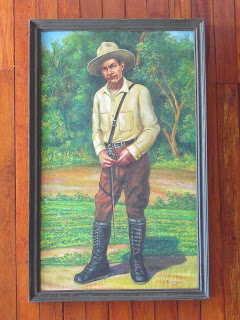After spending some time in Granada, we moved on to Gran Pacifica, a beach community to the west of Managua. I decided to take a one day trip to nearby Leon, the second largest city in Nicaragua. My day began with climbing on a 'chicken' bus (the nickname is commonly used to describe local buses that transport just about anything including animals) and taking the three hour ride to Leon. It was a long hot ride but a fascinating glimpse into the everyday life of Nicaraguan people. After arriving in Leon at the bustling city bus station, I was struck yet again by the incredible colour and vibrancy of all the street markets.

Leon is home to the second oldest university in Central America and has a deserved reputation of being a place of liberal ideas. There are countless murals throughout the city commemorating the price the people, and particularly students, paid to express these ideas in the face of the authoritarian regime in Managua, the capital city. Augusto C. Sandino, national hero and leader of the anti-U.S. rebellion from 1927-1933, is seen everywhere in Leon in murals and statues. He was assassinated in 1934 and his legacy led to the formation of the FSLN (Sandinista National Liberation Front) which finally overthrew the dictatorial Somoza regime in 1979.
There are many cathedrals in Leon including the Cathedral Basilica of the Assumption which is the largest cathedral in Central America. It sits at the heart of the city facing Parque Central. Although the interior is beautiful, it is the rooftop with its many bells, statues, and domes that is the most intriguing. It is also the best place to view the city and the surrounding countryside including numerous volcanoes. There are numerous other cathedrals from the colourful El Calvario church to the La Merced church to the San Juan church to the Recoleccion church.


The most fascinating place in Leon is the Museo de la Revolucion. It is housed in a former government building of the Somoza government and was a central location during the Sandinista revolution in the city. There are small displays including photographs on the lower level but the real attraction is the building itself. The hallways are marked by bullet holes and the tours are given by former Sandinista revolutionary fighters. Our guide told us numerous gripping stories about the fight against the government and showed us where student protestors and guerrilla fighters were kept and executed on the second floor. The atrocities of the American supported Contras have been recounted for us numerous times during our stay here in Nicaragua but walking through this building while hearing them made them even more powerful. An added bonus was being able to walk across the very rickety roof (no Canadian tourist site would have let you walk across it) to get a fantastic view of the Leon cathedral. Leon definitely was worth the many bumpy, hot hours on a crowded bus.

























































No comments:
Post a Comment